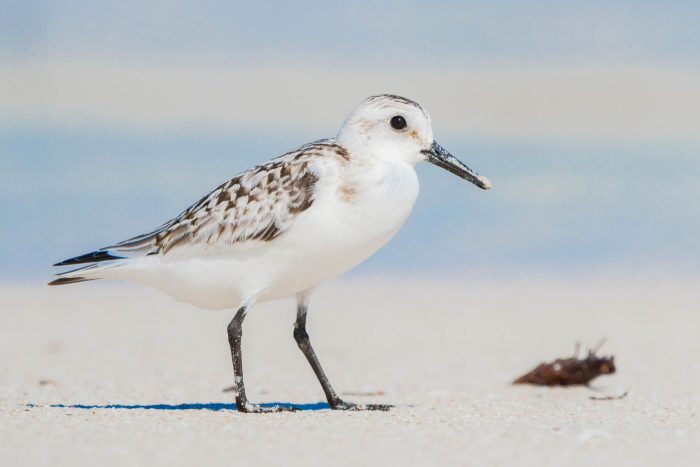Sanderling
Calidris alba
The sanderling is a small, pale sandpiper with black legs and a straight black bill and visits the beaches and tidal flats of the Chesapeake Bay from autumn through spring.
This section shows one large critter image at a time. Use the thumbnails that follow to select a specific image to display here.

This gallery contains a grid of small thumbnails. Selecting a thumbnail will change the main image in the preceding section.
Appearance
Sanderlings have a small, stout body that grows to seven to eight inches in length with a wingspan of 14 inches. Their plumage is brownish-gray in spring and grayish-white in winter. They have a white belly and a broad, white stripe bordered by black on their wings. They have a straight black bill and black legs.
Feeding
This bird eats small, beach-dwelling animals such as bristle worms, amphipods, mollusks and crustaceans. It feeds at the water’s edge by probing the sand with its bill. Small flocks dart along the water’s edge, quickly running away from incoming waves.
Predators
Few predators exist outside of the sanderling's breeding grounds. When they nest and breed in the high Artic tundra, jaegers, glaucous gulls, snowy owls, artic foxes, and wolves are predators. In the winter when sanderlings migrate, peregrine falcons are a predator and when threatened by avian predators like the falcon, sanderlings take flight in a packed group and fly over the ocean.
Flight
Sanderlings fly in flocks. Their white wing stripe is visible during flight. If disturbed, they will quickly fly away.
Voice
Usually silent, sanderlings may make a soft wick-wick sound.
Reproduction and life cycle
Sanderlings do not nest and breed in the Bay region, instead breeding on islands along the rocky coast of the high Arctic tundra. Once their chicks hatch, sanderlings migrate south through the Chesapeake Bay region for the winter. They can live for 13 years.
Did you know?
- Sanderlings are one of the most widespread wintering shorebirds in the world. They can be found from Massachusetts to the tip of South America.
- They are the only sandpiper that lacks a hind toe. This allows sanderlings to be strong runners.
Sources and additional information
- Life in the Chesapeake Bay by Alice Jane Lippson and Robert L. Lippson
- Animal Diversity Web: Calidris alba – University of Michigan Museum of Zoology
- All About Birds: Sanderling – The Cornell Lab of Ornithology
- NatureWorks: Sanderling – New Hampshire Public Television
